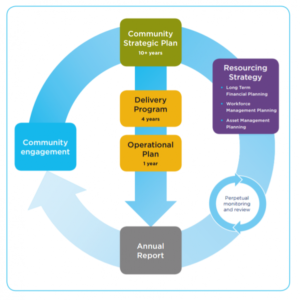In 2023, bikeresource.org was archived. Here are some of the resources saved:
National
National Cycling Strategy
The most recent National Cycling Strategy (2011-2016) was developed in 2010 as a coordinating framework that identifies responsibilities of all levels of government, community and industry stakeholders to encourage more people to get on their bicycles and start riding for a better life. The Australian Bicycle Council published annual Implementation Reports, for example the final one, National Cycling Strategy: Implementation Report 2016. In 2017 there was a review of the Australian Bicycle Council and the National Cycling Strategy and a decision to cease both.
There was an earlier National Cycling Strategy 2005-2010, and others dating back at least as far as 1999.
The National (or Commonwealth or Australian) Government doesn’t have much interest or responsibility for cycling. The possible areas of policy overlap are:
- Health – increasing physical activity
- Workplace Health and Safety – for food delivery riders, at least
- Environment – emissions reduction, air quality, water pollution (from tyre & brake residue in road runoff)
- Tax – fringe benefits tax, salary deductibles, GST on bikes, import duties on ebikes, petrol tax
- Energy security – reducing vulnerability to disruptions to oil supplies
- Productivity – economic productivity improvements from reducing congestion around ports, airports and key employment areas
Cycling and Walking Australia and New Zealand (CWANZ)
Cycling and Walking Australia and New Zealand (CWANZ) was set up in 2018 as the Australasian lead reference group for walking and bike riding on transport and recreation networks. Members include senior and executive level leaders from all Australian state and territory transport agencies, New Zealand Transport Agency, local government representatives and leading advocacy groups and peak bodies for walking, cycling, health and mobility. CWANZ provides a collaborative forum across Australia and New Zealand to share knowledge and innovation on strategic initiatives and projects that enhance outcomes for walking and cycling.
The website has good links to plans, strategies and guides from all the Australian and New Zealand jurisdictions.
NSW
Future Transport
“The Future Transport 2056 Strategy is focused on six key outcomes for the future of mobility in the state, which together aim to positively impact the economy, communities and environment of NSW.”
1. Customer Focused - Every customer experience will be seamless, interactive and personalised by technology and big data. 2. Successful Places - The liveability, amenity and economic success of communities and places are enhanced by transport. 3. A Strong Economy - The transport system powers NSW’s future $1.3 trillion economy and enables economic activity across the state. 4. Safety and Performance - Every customer enjoys safe travel across a high performing, efficient network. 5. Accessible Services - Transport enables everyone to get the most out of life, wherever they live and whatever their age, ability or personal circumstances. 6. Sustainable - The transport system is economically and environmentally sustainable, affordable for customers and supports emissions reductions.
Greater Sydney
The Greater Sydney Commission is leading metropolitan planning to make Greater Sydney more productive, sustainable and liveable. Greater Sydney is growing fast. The region will be home to about 1.6 million more people over the next 20 years. They have a direct reporting line to the NSW Government.
Three Cities Greater Sydney will be a global metropolis of three productive, liveable and sustainable cities: Western parkland city (Western Sydney Airport), Central river city (Paramatta) and Eastern harbour city (Green Square/Mascot).
NSW Bike Plan
RTA Action for Bikes – BikePlan 2010 NSW
Action for Bikes sets out a costed, 10 year plan for the creation of a series of arterial bicycle networks across NSW. It is a $251 million program that will create an average 200 kilometres of cycleways across NSW per year.
To summarise, the 4 strategies are: 1. Improve the bike network 2. Make it safer to cycle 3. Improve personal and environmental health 4. Raise community awareness
Local
Community Strategic Plan
“The Community Strategic Plan represents the highest level of strategic planning undertaken by a local council. All other plans developed by the council as part of the Integrated Planning and Reporting framework must reflect and support the implementation of the Community Strategic Plan.
At the end of each council term (every 4 years) a report is prepared by the council to the community which examines what progress has been made towards the achievement of outcomes identified in the Community Strategic Plan.
- Note in 2017 there were some delays / inconsistent timeframes due to the possible council mergers which did or did not take place.
Integrated Planning and Reporting
This framework allows NSW councils to draw their various plans together, understand how they interact and get the maximum leverage from their efforts by planning holistically for the future.
Transport Strategy / Plans
A transport plan will outline how the various transport modes for the local government area are integrated. Waverley Council’s People, Movement and Places. It will likely mention current and future bicycle priorities and projects.
Cycling Strategy / Bike Plans[edit]
A cycling specific strategy / plan often outlines details around cycling participation and outline specific projects that have been prioritised for implementation. Note that local government often works with the State government to gain funding for building the infrastructure. Often, the infrastructure is too expensive for the local government to build alone. State government funding is an annual process.
Back to BikeResource
